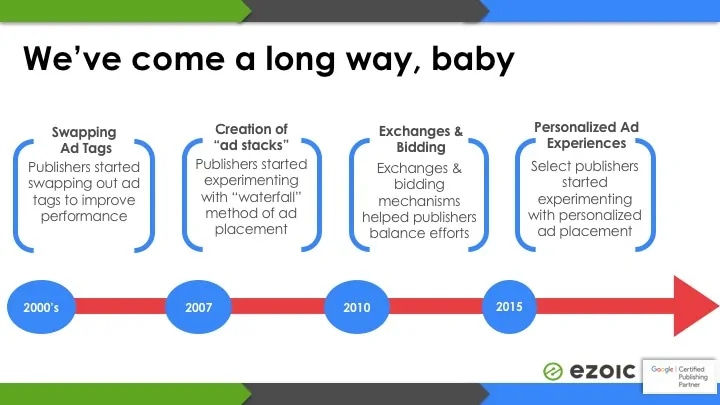Select Ad Placements That Work
Finding ad placements that can earn strong revenue without annoying visitors is considered the holy grail for many publishers. User behavior on the web is shifting on nearly a daily basis, and the ability to implement the best ads is a challenge that is getting harder and harder to manage. Below we’ll show you exactly how you can scale the process of testing and identifying ad placements that will work better than others.
It’s extremely important to remember that showing ads on your site is not just about which placements, sizes, etc. can earn you the most revenue per click. Sometimes, these high earning ads can cause users to bounce or leave your site faster than others. This means that overall (and long term) you will actually make less. Additionally, if these ads negatively affect user experiences long enough, we’ve seen this negatively impact SEO as well.

A History Lesson On Ad Optimization
Publishers have been trying to improve ad performance on their sites for years. This has mainly focused on the demand side. Publishers have tried to maximize how their inventory is bought by networks and exchanges.
Early on, publishers would simply swap ad network tags in and out to determine which ones best-affected revenue. Years later, the popular waterfall method would be adopted. This is where publishers would swap out multiple tags to create ad stacks that seemingly allowed them to find the best combination of networks for their site.
Over time, this led to the creation of ad exchanges (Google AdX being the gold standard of exchanges) and header bidding. These bidding methodologies allowed for an even more optimal mechanism for publishers to ensure that the demand for their inventory is maximized.
We’ve seen that the best way to manage all these methods together is through ad mediation. Exchanges aren’t always fair and competition is the best way to ensure that the publisher comes out on top.

Personalized Ad Placements Control Supply Side
If publishers maximize the demand side of their ad inventory, the next thing for them to do is maximize the supply side. Unfortunately, this is where most publishers have spent very little time.
In the beginning, publishers will often use AdSense features like A/B testing to test different ad placements. This will usually uncover the premise of this entire article — which is — some ad placements simply do better than others.
The secret is figuring out which ones actually work the best, on which kinds of sites, for which kinds of users. It seems like a lot… because it is. When you take into account the user attributes that impact ad performance — like geolocation, demographics, time of day, user history, and more — you learn that finding the right combination for a single individual user takes thousands of variables into consideration. Not mention, this assumes that once you optimize for that one user on your site that the rest will be the same. Unfortunately, this isn’t the case, but all is not lost.
Next, we’ll go into what affects ad placement success and how site owners can go about finding ad placements that work well on their site.

There Are A Lot of Variables With Ad Placements
Obviously, we can agree that creating a personalized ad experience for each user is by far the best way to ensure that the supply side of your ad inventory is taken care of. However, as we discussed above, this takes a lot of consideration.
Things to consider…
Geo-location – Where is a user is coming from will impact their sensitivity to different kinds of ad placements.
Time of day – What time the user is visiting a site has a dramatic impact on their tolerance for different kinds of ads.
Demographic – It’s obvious that users of different ages, genders, and more play a factor when determining how they will browse a site. Knowing what could make them bounce is important
History – Knowing a user’s past behavior and if they are returning or a new user can make a huge difference in the types of ads that will be successful for each.
Picking The Right Ad Combinations
The best ad combination is one that is tailored to the users. Any type of A/B testing will be a small generalized sample that ultimately will leave out many users.
Fortunately, publishers can leverage free tools to customize ad experiences for users while still using all of their existing partnerships. This has been proven time and time again to improve both revenue and user experience metrics.
Matching Supply & Demand
To truly maximize ad earnings publishers must take UX into account. This can only be done at a user-by-user level and this is why personalized ad placements are critical to optimizing the supply side of a publisher’s ad inventory.
Additionally, to fully maximize earnings, publishers must also have a demand side that can offer them the best potential earnings for their inventory as well. While many publishers are still using the waterfall method to manage this, it has been proven over time that ad exchanges and header bidding strategies are much more effective in managing this demand.
Furthermore, making all of these environments competitive through mediation is likely the most efficient way to handle these partners.
At the end of the day, maximizing revenue is a balancing act that includes millions of variables. Trusting humans to manage it all is nearly impossible. That’s why it is so important to leverage tools and parties capable of doing the math for you. Hopefully, this has helped you select the best ad placements for your site.


